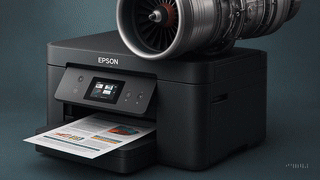By Celeste Dame 🚀🧠
After watching Ray Stasieczko break down Epson’s FY2024 numbers on his show End of the Day with Ray, I couldn’t stop thinking about the gap between potential and performance. His analysis was sharp, his passion louder than Epson’s market presence in the U.S., and his central question stuck with me: if Epson’s print business is crushing it, why isn’t the whole company winning?
Here’s my take.
Despite having the best margins in the business and disruptive inkjet tech, Epson risks losing its edge by chasing distractions instead of crushing weaker rivals like Konica Minolta.
Epson just posted strong numbers for its FY2024 print business: $6.8 billion in revenue with a segment profit of 12.7%. That's not just healthy, it’s elite in a category that’s been limping along post-COVID. But zoom out, and the whole picture gets fuzzy. The conglomerate’s total operating profit came in at just 5.5%. That raises a question worth asking. If Epson’s print engine is this powerful, why is the vehicle barely moving?
Some of that answer lies buried in the financials. Adjustments and corporate expenses shaved nearly $400 million off the table, with a cryptic $49 million loss attributed to “eliminated intersegment transactions” and R&D for unspecified “new businesses.” But you don’t need a forensic accountant to spot the obvious. Epson’s profitability is being dragged down by everything that isn’t print.
And print, specifically inkjet, is where the future sits.
Print is the Profit Engine
Break down the numbers, and the strength of Epson’s core print business is hard to miss. Commercial and industrial print brought in $2.1 billion with a margin of 20.3%. Home and office print did $4.7 billion at 9.4%. Together, the print division delivered $866.9 million in profit.
Epson’s inkjet strategy has long been quietly disruptive. Their PrecisionCore heat-free technology is a credible alternative to the traditional laser printer. It’s simpler, more energy-efficient, and aligns well with sustainability trends. Yet, instead of owning that narrative and bulldozing market share from vulnerable competitors, Epson seems distracted, pursuing acquisitions and initiatives that dilute focus and margin.
The Missed U.S. Opportunity
Look at the U.S. numbers, and the missed opportunity becomes even clearer. Despite the size of the U.S. market, Epson only pulled $1.4 billion in U.S. print revenue last year, just 21% of its total print business. That includes a meager $122 million from its promising "office shared" category, where its inkjet units could directly challenge legacy A3 laser MFPs.
To put that in perspective, many regional dealers in the U.S. do more revenue than Epson’s entire "office shared" category here. The product is solid. The execution isn’t.
If there’s a gap to close, it’s not technical. It’s strategic.
A Competitive Opening: Konica Minolta’s Stumble
The missed opportunity is even more glaring when you stack Epson next to Konica Minolta. At a glance, Konica’s office print division, which excludes production print and IT services, is on track to post around $3.5 billion this year. That’s about the same as Epson’s global SOHO print revenue.
But here's the kicker. Konica’s profitability has been weak for years. They've posted losses, missed forecasts, and taken write-downs on “moonshot” tech initiatives. Their recent warnings suggest yet another unprofitable year is coming.
In short, Epson has a rival with a weaker balance sheet, older tech, and fading channel loyalty. Yet they’re not going for the throat. Why not?
Ray Stasieczko, in his recent breakdown of Epson’s FY2024 report, offered a fitting metaphor: “Get the garden hose, shove it down their throat, and turn on the spout.” That’s a bit aggressive, but in a shrinking market, this kind of decisive strategy is what wins.
The Fiery Detour
Then there’s the Fiery acquisition. Epson paid $572 million for the digital front-end company, spinning it as a strategic move to strengthen their print portfolio. But let’s be honest. Fiery generates modest revenue (likely under $300 million annually), and the independent neutrality that made it useful to other OEMs may erode now that it’s owned by one of their competitors.
This feels less like a masterstroke and more like Ricoh’s purchase of DocuWare, interesting but irrelevant to the broader battle. If Fiery ends up contributing just 2 to 3 percent to Epson’s total revenue and doesn’t catalyze channel expansion, the acquisition will be a distraction rather than a growth engine.
And worse, it may alienate the very OEMs who helped Fiery thrive in the first place.
A Strategic Fork in the Road
There’s no mystery here. Epson’s core print business is outperforming. Its inkjet technology is well-positioned to win over disillusioned laser customers, especially in the A4 office space where sustainability, simplicity, and service costs are under increasing scrutiny.
But to turn potential into dominance, Epson has to do three things:
-
Double down on the channel. Independent dealers remain the gateway to SMB and mid-market print installs. Epson’s minimal footprint in this space is a liability. Equip, train, and compensate the channel aggressively to push inkjet over laser. That’s the real battlefield.
-
Kill the distractions. All non-print R&D, “other businesses,” and underperforming ventures should be trimmed. Reinforce what’s working, inkjet, and put serious energy behind market conversion.
-
Target the weak links. Konica Minolta, Ricoh, and others are vulnerable. Many dealers are open to new partners if the product, margins, and support align. Epson needs to seize this moment and take share before someone else does. Perhaps HP or Kyocera, both of whom are equally inkjet-capable.
Final Thought
Inkjet isn’t the future. It’s the present, and Epson owns the better mousetrap. But better tech doesn’t win markets. Focus does. Channel loyalty does. And execution definitely does.
The next two years will determine whether Epson emerges as the print disruptor it was meant to be, or just another technically sound company that never quite capitalized on its moment.
The industry doesn’t need another sleeping giant. It needs a fighter.


No comments:
Post a Comment